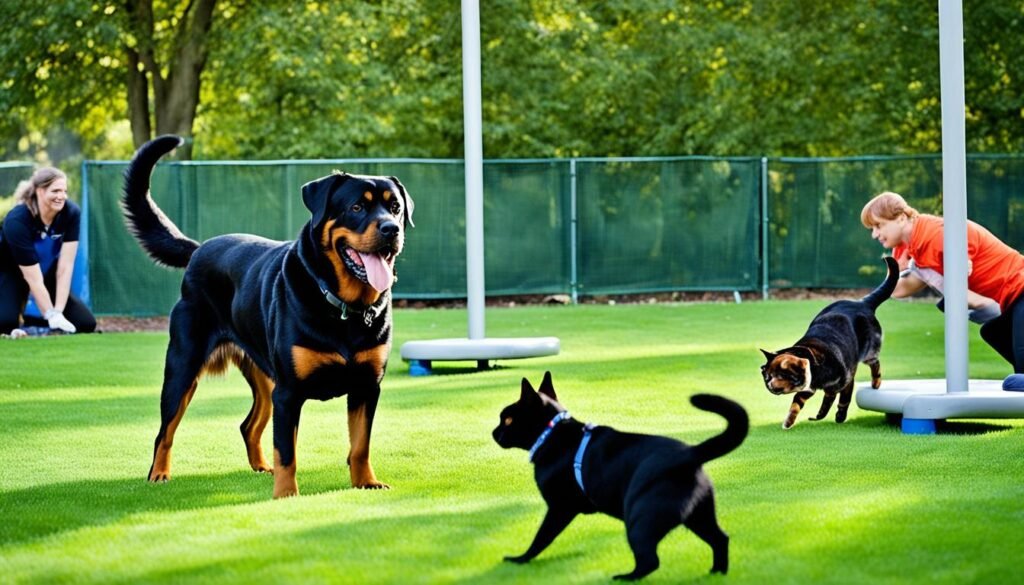Welcome to my guide on creating a harmonious relationship between Rottweilers and cats. While Rottweilers are often misunderstood as aggressive dogs, they can actually get along quite well with cats. However, it’s important to consider various factors and take the necessary steps to ensure compatibility and a positive coexistence. In this article, I will provide you with valuable insights and tips on introducing Rottweilers to cats, fostering a positive relationship, and managing their interactions. Let’s dive in!
Key Takeaways:
- With proper socialization, Rottweilers can get along well with cats.
- Consider the Rottweiler’s temperament and the cat’s personality when introducing them.
- Gradual introductions and controlled interactions are crucial for a positive relationship.
- Creating a safe environment with clear boundaries is essential.
- Training and positive reinforcement play a significant role in fostering a harmonious bond between Rottweilers and cats.
The History of Rottweilers
Rottweilers have a fascinating history as working dogs. This breed originated in the town of Rottweil, Germany, where they were primarily used for herding cattle. Their strong and powerful bodies, combined with their intelligence and loyalty, made them excellent companions for cattle drivers.
In addition to herding, Rottweilers also played a vital role in providing security for traders. As the cattle market thrived in Rottweil, these dogs were entrusted with protecting the merchants’ money as they traveled through dangerous areas. With their keen senses and courageous nature, Rottweilers quickly became known as reliable guardians.
Over time, Rottweilers’ abilities and versatility led to their utilization in various fields. Their strength and working drive made them ideal for pulling carts and transporting heavy loads. They were also employed as police and crowd control dogs, thanks to their intimidating presence and natural protective instincts.
Today, Rottweilers continue to be valued as working dogs as well as beloved family pets. Their history as herding dogs, guardians, and working companions has shaped their temperament and characteristics, making them loyal, confident, and protective. The legacy of their esteemed history is evident in every Rottweiler you meet.
Key Points:
- Rottweilers originated in Rottweil, Germany, where they were primarily used as herding dogs.
- They later became trusted companions for traders, guarding their money during travels.
- Rottweilers’ strength and intelligence led to their involvement in various tasks, such as pulling carts and working as police and crowd control dogs.
- Their history as working dogs has shaped their protective nature and loyalty.
Rottweilers and Cats: Compatibility and Behavior

Rottweilers and cats are two very different animals with distinct behaviors, but with proper socialization, they can coexist peacefully. It’s essential to understand their compatibility and behavior to foster a harmonious relationship between them.
Rottweilers have a strong chase instinct, which stems from their history as herding and working dogs. This instinct may be triggered when they see a cat’s quick and darting movements. However, it’s important to note that not all Rottweilers are the same, and individual personalities play a crucial role in their behavior towards cats.
Well-socialized Rottweilers, who have been exposed to different animals from an early age, are more likely to accept cats as part of their pack. Through consistent and positive socialization efforts, Rottweilers can learn to see cats as friends rather than prey.
In some cases, Rottweilers may even become protective of cats within their family. As pack-oriented dogs, Rottweilers have a natural instinct to guard and protect their loved ones, including other animals they consider part of their pack.
However, it’s important to remember that compatibility between Rottweilers and cats is not guaranteed solely by their instincts. Rottweilers require proper socialization to understand acceptable behavior around cats. Positive experiences with cats during their formative months can shape their perception and help them develop a positive association.
When introducing a Rottweiler to a household with cats, it’s crucial to facilitate controlled interactions. This allows the Rottweiler and cat to gradually get accustomed to each other’s presence while ensuring the safety of both animals. Keeping the Rottweiler on a leash during the initial introductions can provide better control over their behavior and reactions.
Additionally, providing the cat with vertical space, such as shelves or a cat tree, allows them to observe the Rottweiler from a safe distance and establish a sense of security. This can help alleviate any stress or fear the cat may experience during the introduction process.
Socialization is the Key
Socialization is the cornerstone of successful coexistence between Rottweilers and cats. By gradually exposing Rottweilers to cats and providing positive experiences, you can help them develop a positive view of their feline companions.
Start the socialization process early, ideally during the Rottweiler’s puppyhood. Introduce them to cats in a controlled and supervised environment, allowing them to interact at their own pace while observing their behaviors for signs of stress or aggression.
It’s important to manage the Rottweiler’s dominance tendencies during interactions with cats. Reinforcing positive behavior and rewarding calm and gentle interactions can help them understand the desired behavior around their feline friends.
Socialization is an ongoing process that should continue throughout your Rottweiler’s life. Regular exposure to cats and other animals in positive environments will reinforce their social skills and maintain their compatibility with cats.
In conclusion, while Rottweilers have a chase instinct and dominance tendencies, proper socialization can enable them to coexist harmoniously with cats. Ensuring a safe and controlled introduction, along with consistent socialization efforts, is key to fostering a positive relationship between these two unlikely companions. Remember that every dog and cat is unique, and individual personalities should be considered when determining their compatibility.
Considerations for Owning a Rottweiler and Cat

When it comes to owning a Rottweiler and a cat, there are several important considerations to keep in mind. While Rottweilers can make wonderful companions, they may not be the best choice for first-time dog owners. Here are some factors to consider:
- Socialization: Rottweilers require strong socialization from an early age. This breed needs to be exposed to various people, animals, and environments to develop good manners and adaptability. If you’re new to dog ownership, the socialization needs of a Rottweiler may be more challenging compared to other breeds.
- Commitment: Rottweilers are known for their loyalty and protective nature. However, these qualities require a significant commitment of time and attention. Rottweilers thrive on human interaction and need daily exercise and mental stimulation to prevent boredom and potential behavioral issues.
- Breed Options: If you’re considering a big dog as your first pet, there are other breeds like German Shepherds or Golden Retrievers that may be more suitable for first-time dog owners. These breeds are generally known for their friendly and easygoing nature, making them easier to handle for novice owners.
- Breed Reputation: Rottweilers have been unfairly labeled as aggressive dogs. While they can be protective, it’s important to remember that individual temperament plays a significant role. Proper socialization and responsible ownership are key factors in determining a Rottweiler’s behavior towards other pets, including cats.
Before introducing a Rottweiler to a cat, assess your experience as a dog owner and consider the specific needs of both the Rottweiler and the cat. It’s crucial to provide proper socialization and a structured environment to ensure a harmonious coexistence between the two. With patience, commitment, and responsible ownership, many Rottweilers and cats can develop positive relationships.
Tips for Introducing a Rottweiler to a Cat Home

When introducing a Rottweiler to a cat home, it’s crucial to consider the animal personalities involved. Each pet has its own unique characteristics and preferences, and a successful introduction requires careful planning and gradual steps.
Gradual Introduction
Introducing a Rottweiler to a cat should be a gradual process to ensure a positive interaction. Start by keeping the Rottweiler and cat in separate spaces, allowing them to become familiar with each other’s scents before any physical contact occurs. This will help reduce any initial tension or anxiety.
Leash Control
During the initial introduction, it’s important to keep both the Rottweiler and cat on a leash for added control and safety. This allows you to maintain distance between them while observing their reactions and ensuring they remain calm. If any signs of aggression or discomfort arise, you can easily separate them.
Scent Introduction
Introducing scents can be an effective way to help the Rottweiler and cat become familiar with each other. You can rub a cloth or towel on each pet and then swap the scented items between them. This allows them to associate each other’s scent with positive experiences, creating a sense of familiarity.
Controlled Interaction
Once the Rottweiler and cat have become more comfortable with each other’s presence and scents, you can gradually progress to controlled interactions. Keep them on their leashes and allow them to approach each other at their own pace. Be patient and observant, rewarding calm and positive behavior with treats and praise.
It’s important to remember that each introduction is unique, and the timeline for integration may vary depending on the personalities of the pets involved. Give them time to adjust and always prioritize their safety and well-being. Providing a safe space for the cat to retreat if needed is essential. With patience, consistency, and positive reinforcement, a harmonious relationship between a Rottweiler and a cat can be achieved.
Tips for Introducing a Cat to a Rottweiler Home

Introducing a cat to a Rottweiler home requires careful consideration to ensure a smooth transition and a harmonious relationship between the two. Here are some tips to help you introduce your cat to your Rottweiler and create a safe and welcoming environment:
1. Scent Introduction
Before allowing direct interactions between your cat and Rottweiler, it’s important to introduce their scents to each other gradually. Swap blankets or bedding between them, allowing them to become familiar with each other’s smells. This scent introduction can help them get acquainted and reduce any tension during their first physical meeting.
2. Supervised Interactions
When it’s time for your cat and Rottweiler to meet face-to-face, always ensure that the interactions are closely supervised. Keep both pets on a leash initially and maintain control over the situation. This will allow you to intervene if necessary and prevent any potential conflicts or aggressive behavior.
3. Separate Zones
Providing separate zones for your cat and Rottweiler can help them feel more secure and reduce the chances of territorial disputes. Set up designated areas in your home where each pet can retreat to when they need their own space. This will give them a sense of ownership and help avoid unnecessary confrontations.
4. Vertical Space
Cats often feel safer when they have access to vertical space, such as cat trees or shelves. These elevated areas allow them to observe their surroundings and escape from any perceived threats or uncomfortable situations. Providing vertical space for your cat can help them feel more at ease in their new Rottweiler home.
5. Closely Monitor Interactions
It’s essential to closely monitor the interactions between your cat and Rottweiler, especially during the initial stages of their introduction. Look for any signs of aggression or discomfort, such as growling, hissing, or raised hair. If any negative behavior arises, separate them immediately and consult with a professional if needed.
By following these tips and implementing a gradual introduction process, you can help your cat and Rottweiler build a positive relationship and coexist peacefully in their shared home.
Managing Interactions and Anxiety

When it comes to integrating Rottweilers and cats into the same household, managing their interactions is essential for a harmonious coexistence. Both Rottweiler behavior and cat behavior should be carefully observed to ensure a positive and safe environment for both pets.
Rottweilers may naturally exhibit signs of anxiety when faced with new situations or unfamiliar animals, such as cats. It’s crucial to watch for any signs of stress or discomfort in your Rottweiler, such as excessive barking, pacing, or avoidance behaviors. By addressing their anxiety, you can help create a more peaceful environment for both pets.
One effective strategy for managing interactions is to provide escape routes for your cat. This allows them to have a safe space where they can retreat if they feel overwhelmed or threatened by the Rottweiler. Vertical spaces, such as cat trees or shelves, can also provide a sense of security and allow cats to observe from a distance if needed.
Another important consideration is feeding separation. By providing separate feeding areas for your Rottweiler and cat, you can prevent potential conflicts over food. This reduces the chances of food aggression and helps promote a calm feeding environment for both pets.
Creating a positive and calm environment for both your Rottweiler and cat is key to managing interactions and reducing anxiety. This can involve using positive reinforcement techniques to reward calm and appropriate behavior. Additionally, ensuring that both pets have their individual spaces and personal belongings helps foster a sense of security and reduces potential sources of tension.
Remember, every Rottweiler and cat is unique, so it’s important to observe their behavior closely and make adjustments accordingly. If you’re unsure about managing their interactions or addressing anxiety, it may be beneficial to consult with a professional dog trainer or animal behaviorist who can provide expert guidance tailored to your specific situation.
Importance of Socializing Your Rottweiler

Socializing your Rottweiler is crucial for their overall behavior and their ability to get along with cats. By providing proper obedience training and positive socialization experiences, you can establish yourself as the leader and foster a pack mentality within your Rottweiler. This will help them understand their role in the family and promote positive interactions with other animals, including cats.
Early socialization is key to preventing future problems and ensuring your Rottweiler grows up to be a well-adjusted and friendly companion. By exposing them to various pets and people in their early stages of life, you can help them become comfortable and confident in different social situations.
Positive experiences during socialization are essential in shaping your Rottweiler’s behavior and attitude towards cats. Encourage them to have positive interactions with cats by offering treats, praise, and rewards when they display calm and friendly behavior. This will create a positive association in their minds and reinforce their understanding that good behavior leads to positive outcomes.
- Take your Rottweiler to obedience classes where they can interact with other dogs and learn important commands.
- Expose your Rottweiler to different environments, sights, and sounds to help them become adaptable and less likely to be fearful or reactive around cats.
- Introduce your Rottweiler to well-behaved cats gradually and under controlled circumstances. Always prioritize the safety and comfort of both the Rottweiler and the cat during these introductions.
- Regularly socialize your Rottweiler throughout their life to maintain their positive behavior and prevent regression.
Remember, socializing your Rottweiler is a lifelong process. By investing time and effort into their socialization and obedience training, you can significantly increase their chances of developing a positive and harmonious relationship with cats and other pets.
Creating a Safe Environment for Rottweilers and Cats

When bringing Rottweilers and cats together, it is crucial to establish a safe environment that promotes harmony and ensures the well-being of both pets. Here are some essential considerations:
Setting Clear Boundaries
Creating clear boundaries is essential to establish rules and expectations for both Rottweilers and cats. This can be achieved by using baby gates or pet doors to separate different areas of the house and prevent unwanted interactions.
- Install baby gates or pet doors to limit access to certain rooms or areas.
- Provide separate feeding areas to avoid conflicts over food.
- Define safe zones where the cat can retreat and feel secure.
Providing Separate Spaces
Offering separate spaces for Rottweilers and cats allows them to have their own personal areas and reduces the likelihood of confrontations. Here’s how you can create separate spaces:
- Provide separate sleeping areas, such as individual beds or crates, for both pets.
- Designate specific areas where the cat can climb and perch, such as cat trees or shelves.
- Ensure each pet has their own litter box and scratching post.
Vertical Space and Supervision
Vertical space allows cats to feel safe and observe their surroundings from a higher vantage point. This helps reduce stress and potential conflicts with Rottweilers. Additionally, providing proper supervision during their interactions is crucial for maintaining a safe environment.
- Install cat shelves or perches at different heights for the cat to climb and rest.
- Supervise initial interactions between the Rottweiler and the cat to ensure their safety and intervene when necessary.
- Gradually increase supervised interactions, keeping a vigilant eye on their behavior and body language.
Vaccinations and Regular Check-ups
Keeping both your Rottweiler and cat up to date on vaccinations and regular veterinarian check-ups is vital for their overall health and well-being. Here’s what you should do:
- Ensure your Rottweiler is up to date on all necessary vaccinations as recommended by your veterinarian.
- Ensure your cat is also up to date on vaccinations, including those specifically recommended for indoor cats.
- Schedule regular check-ups with your veterinarian to monitor their health and address any concerns.
By creating a safe environment with clear boundaries, separate spaces, vertical space, and proper supervision, you can promote a harmonious coexistence between your Rottweiler and cat. Remember, their well-being is your responsibility as a pet owner.
Training for Better Relationships Between Rottweilers and Cats

Training plays a crucial role in establishing better relationships between Rottweilers and cats. With the right approach and techniques, you can foster a harmonious and peaceful coexistence between these two unlikely companions.
One effective training method is positive reinforcement, which involves rewarding good behavior. By praising and rewarding your Rottweiler for exhibiting calm and friendly behavior around cats, you can help prevent conflicts and encourage a positive association.
Behavior problems can arise when introducing Rottweilers to cats, but these issues can be addressed through training. Whether it’s excessive barking, jumping, or displaying territorial behavior, professional help may be necessary to address these challenges effectively.
Managing Territorial Marking
If your Rottweiler exhibits territorial marking behavior around the presence of cats, proper training can help manage this issue. Creating individual spaces for each pet and implementing consistent house rules can prevent territorial disputes. Additionally, using positive reinforcement techniques to redirect your Rottweiler’s focus towards appropriate behaviors can help eliminate territorial marking tendencies.
Seeking Professional Help
If you’re struggling to establish a positive relationship between your Rottweiler and cat or facing persistent behavior problems, seeking professional help is a wise choice. A qualified dog trainer or animal behaviorist can assess the situation, provide personalized guidance, and develop a training plan tailored to your specific needs.
Conclusion
In conclusion, Rottweilers and cats can coexist and even form friendships with proper introduction and socialization. Despite the Rottweiler’s challenging reputation, responsible ownership and a commitment to training can foster a harmonious relationship between these unlikely companions.
To ensure a successful dog-cat relationship, it is crucial to recognize the individual personalities of each animal. Every Rottweiler and cat is unique, and their compatibility can vary. By paying attention to their specific needs and behaviors, owners can address any potential challenges that may arise.
Responsible ownership involves creating a safe environment for both pets. Setting clear boundaries, providing separate spaces, and offering vertical space for the cat can help prevent conflicts. Regular supervision during interactions and vaccinations for both pets are also key to their overall well-being and long-term friendship.
In summary, a positive dog-cat relationship between Rottweilers and cats is possible through responsible ownership, training, and a safe environment. By prioritizing the individual needs of each pet and addressing any behavior concerns promptly, owners can promote a harmonious coexistence and develop a lasting bond between their Rottweiler and feline companion.
FAQ
Do Rottweilers get along with cats?
Yes, Rottweilers can get along well with cats if properly socialized and introduced.
How can I introduce my Rottweiler to my cat?
Gradual introductions, controlled interactions, and scent swapping can help ease the transition.
Can a Rottweiler become protective of a cat?
Yes, Rottweilers can become protective of cats they see as part of their family.
Should I get a Rottweiler as my first dog?
It is generally not recommended for a Rottweiler to be your first dog due to their need for socialization and commitment.
Are there other dog breeds that are more suitable for first-time owners?
Yes, breeds like German Shepherds or Golden Retrievers may be more suitable for first-time dog owners.
How can I manage interactions between my Rottweiler and my cat?
Providing escape routes for the cat, separating feeding areas, and closely monitoring interactions are important.
What is the importance of socializing my Rottweiler?
Socializing your Rottweiler is crucial for their behavior and ability to get along with other pets, including cats.
How can I create a safe environment for my Rottweiler and cat?
Setting boundaries, providing separate spaces, and supervision during interactions are important for a safe environment.
What training techniques can I use to establish better relationships between my Rottweiler and cat?
Positive reinforcement techniques and addressing behavior problems can help prevent conflicts and establish harmony.
Can Rottweilers and cats coexist and form friendships?
Yes, with proper introduction, socialization, and responsible ownership, Rottweilers and cats can coexist and even form friendships.
